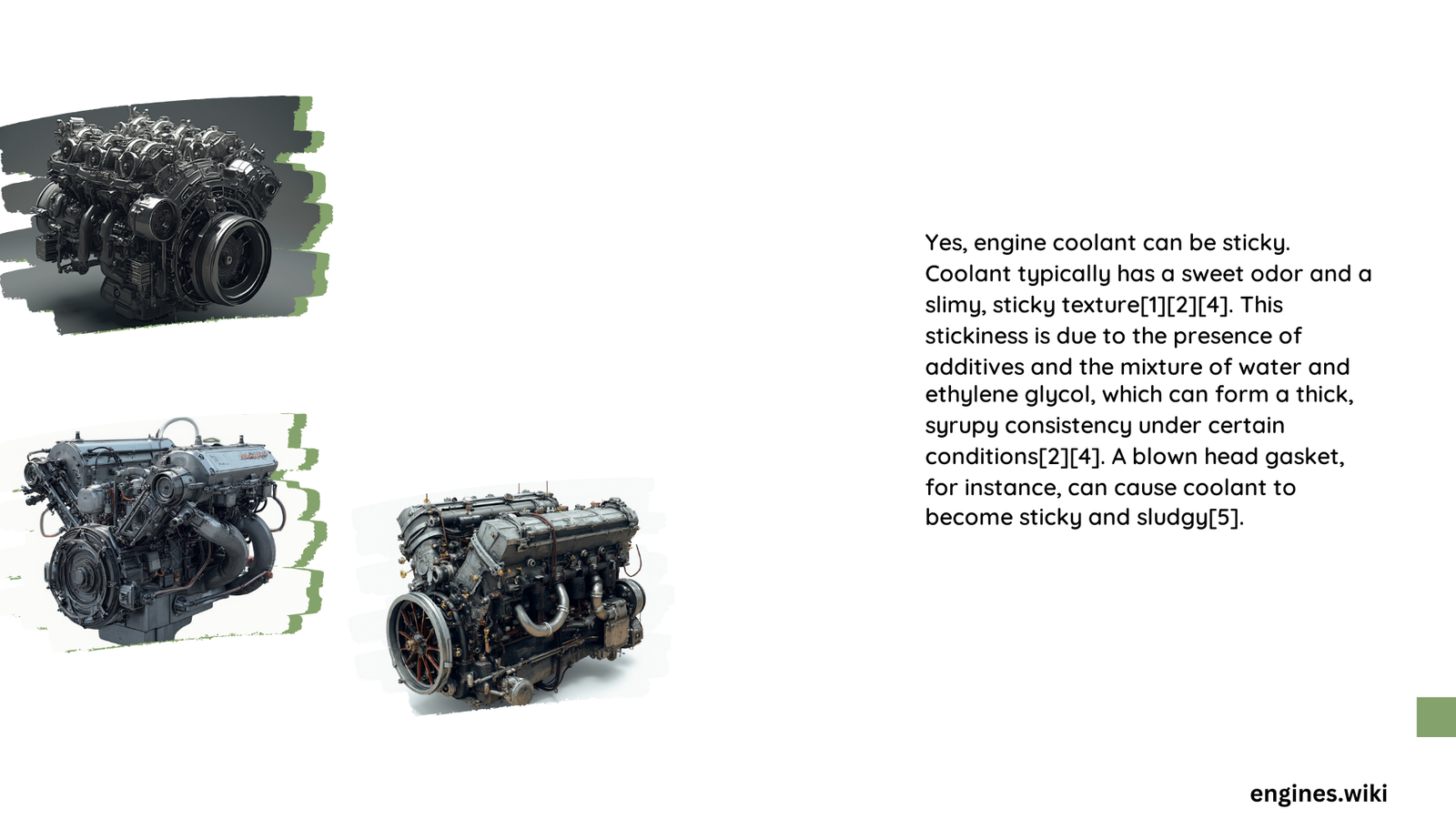Engine coolant, a vital component in vehicle cooling systems, is typically a mixture of glycol and water with various additives. While not inherently sticky like adhesives, coolant can exhibit varying degrees of viscosity depending on temperature and composition. This article explores the properties of engine coolant, factors affecting its consistency, and situations where it might appear sticky.
What Is the Composition of Engine Coolant?
Engine coolant, also known as antifreeze, is primarily composed of:
- Water (typically 50%)
- Ethylene glycol or propylene glycol (typically 50%)
- Corrosion inhibitors
- pH buffers
- Defoamers
- Stabilizers
The glycol component provides freeze and boil-over protection, while the additives protect the cooling system from corrosion and maintain optimal performance.
How Does Temperature Affect Engine Coolant Viscosity?

Temperature plays a crucial role in the viscosity of engine coolant:
-
At Normal Operating Temperatures: Coolant maintains a relatively low viscosity, allowing for efficient flow through the engine.
-
At Low Temperatures: The viscosity increases significantly, potentially leading to a thicker, more ‘sticky’ consistency.
-
At Extremely Low Temperatures: Without proper antifreeze concentration, the coolant can freeze, causing severe engine damage.
Here’s a table showing the dynamic viscosity of a typical ethylene glycol-based coolant at different temperatures:
| Temperature | Dynamic Viscosity (mPa·s) |
|---|---|
| 20°C | 45.37 |
| 0°C | 153.14 |
| -10°C | 325.09 |
As you can see, the viscosity more than triples as the temperature drops from 20°C to -10°C.
Can Engine Coolant Become Sticky Over Time?
While engine coolant doesn’t typically become sticky in the same way as adhesives, it can develop properties that might be perceived as ‘sticky’ under certain conditions:
-
Contamination: Oil or other contaminants can mix with the coolant, creating a sludge-like consistency.
-
Additive Breakdown: Over time, the additives in the coolant can break down, potentially leading to the formation of deposits or a change in consistency.
-
Overheating: Extreme heat can cause coolant to break down and leave sticky residues on engine components.
-
Improper Mixing: Using too much antifreeze concentrate without proper dilution can result in a thicker, more viscous coolant.
What Are the Signs of Degraded or Contaminated Coolant?
Look out for these indicators that your coolant might be degraded or contaminated:
- Change in color (e.g., from bright green to brown)
- Visible particles or debris in the coolant
- Sludge-like consistency when the engine is cold
- Sweet, syrupy smell (indicating a coolant leak)
- Engine overheating
How Often Should Engine Coolant Be Changed?
The frequency of coolant changes depends on several factors:
- Vehicle make and model
- Type of coolant used
- Driving conditions
As a general guideline:
- Traditional coolants: Every 30,000 miles or 2 years
- Extended life coolants: Every 100,000 miles or 5 years
Always consult your vehicle’s owner manual for specific recommendations.
Can Using the Wrong Type of Coolant Cause Stickiness?
Using the incorrect coolant can lead to various issues, including:
-
Incompatibility with seals and gaskets: This can cause leaks and the formation of deposits.
-
Additive precipitation: Different coolant types have different additive packages. Mixing incompatible coolants can cause additives to precipitate out of solution, potentially creating a sticky residue.
-
Reduced heat transfer efficiency: Improper coolant can lead to scale buildup, reducing the system’s ability to transfer heat effectively.
What Should You Do If You Notice Sticky Coolant?
If you observe signs of sticky or degraded coolant:
-
Don’t ignore it: Addressing the issue promptly can prevent more serious engine problems.
-
Flush the system: A complete coolant flush can remove contaminants and degraded coolant.
-
Inspect for leaks: Check for any signs of coolant leaks, which could indicate a more serious problem.
-
Use the correct coolant: Refill the system with the manufacturer-recommended coolant type and concentration.
-
Consider professional service: If you’re unsure about the cause or solution, consult a professional mechanic.
In conclusion, while engine coolant isn’t inherently sticky, various factors can cause it to develop sticky-like properties or leave sticky residues. Regular maintenance, using the correct coolant type, and addressing any issues promptly can help ensure your engine’s cooling system operates efficiently and effectively.
